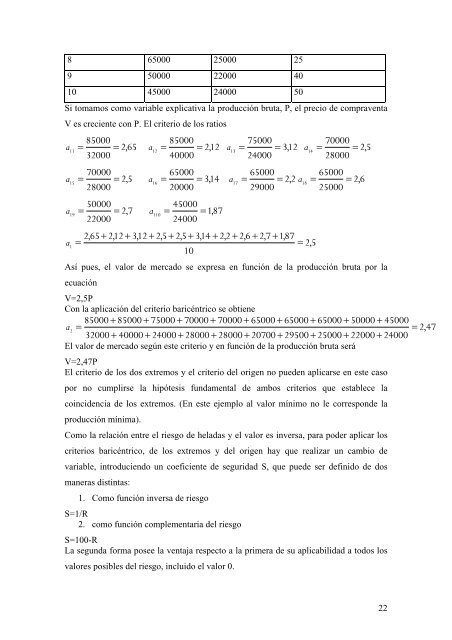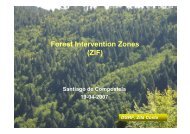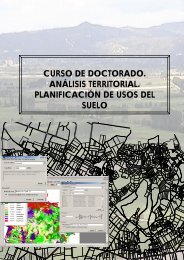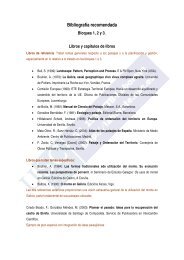3. objeto de la valoración catastral de inmuebles rústicos
3. objeto de la valoración catastral de inmuebles rústicos
3. objeto de la valoración catastral de inmuebles rústicos
You also want an ePaper? Increase the reach of your titles
YUMPU automatically turns print PDFs into web optimized ePapers that Google loves.
8 65000 25000 25<br />
9 50000 22000 40<br />
10 45000 24000 50<br />
Si tomamos como variable explicativa <strong>la</strong> producción bruta, P, el precio <strong>de</strong> compraventa<br />
V es creciente con P. El criterio <strong>de</strong> los ratios<br />
85000<br />
85000<br />
75000<br />
70000<br />
a 11 � � 2,<br />
65 a 12 � � 2,<br />
12 a 13 � � 3,<br />
12 a 14 � � 2,<br />
5<br />
32000<br />
40000<br />
24000<br />
28000<br />
70000<br />
65000<br />
65000 65000<br />
a 15 � � 2,<br />
5 a 16 � � 3,<br />
14 a17 � � 2,<br />
2 a 18 � � 2,<br />
6<br />
28000<br />
20000<br />
29000 25000<br />
50000<br />
45000<br />
a 19 � � 2,<br />
7 a 110 � �1,<br />
87<br />
22000<br />
24000<br />
2,<br />
65�<br />
2,<br />
12 � 3,<br />
12 � 2,<br />
5�<br />
2,<br />
5�<br />
3,<br />
14 � 2,<br />
2 � 2,<br />
6 � 2,<br />
7 �1,<br />
87<br />
a 1 �<br />
� 2,<br />
5<br />
10<br />
Así pues, el valor <strong>de</strong> mercado se expresa en función <strong>de</strong> <strong>la</strong> producción bruta por <strong>la</strong><br />
ecuación<br />
V=2,5P<br />
Con <strong>la</strong> aplicación <strong>de</strong>l criterio baricéntrico se obtiene<br />
85000 � 85000 � 75000 � 70000 � 70000 � 65000 � 65000 � 65000 � 50000 � 45000<br />
a2<br />
�<br />
� 2,<br />
47<br />
32000 � 40000 � 24000 � 28000 � 28000 � 20700 � 29500 � 25000 � 22000 � 24000<br />
El valor <strong>de</strong> mercado según este criterio y en función <strong>de</strong> <strong>la</strong> producción bruta será<br />
V=2,47P<br />
El criterio <strong>de</strong> los dos extremos y el criterio <strong>de</strong>l origen no pue<strong>de</strong>n aplicarse en este caso<br />
por no cumplirse <strong>la</strong> hipótesis fundamental <strong>de</strong> ambos criterios que establece <strong>la</strong><br />
coinci<strong>de</strong>ncia <strong>de</strong> los extremos. (En este ejemplo al valor mínimo no le correspon<strong>de</strong> <strong>la</strong><br />
producción mínima).<br />
Como <strong>la</strong> re<strong>la</strong>ción entre el riesgo <strong>de</strong> he<strong>la</strong>das y el valor es inversa, para po<strong>de</strong>r aplicar los<br />
criterios baricéntrico, <strong>de</strong> los extremos y <strong>de</strong>l origen hay que realizar un cambio <strong>de</strong><br />
variable, introduciendo un coeficiente <strong>de</strong> seguridad S, que pue<strong>de</strong> ser <strong>de</strong>finido <strong>de</strong> dos<br />
maneras distintas:<br />
1. Como función inversa <strong>de</strong> riesgo<br />
S=1/R<br />
2. como función complementaria <strong>de</strong>l riesgo<br />
S=100-R<br />
La segunda forma posee <strong>la</strong> ventaja respecto a <strong>la</strong> primera <strong>de</strong> su aplicabilidad a todos los<br />
valores posibles <strong>de</strong>l riesgo, incluido el valor 0.<br />
22



![Presentación [PDF 168 KB]](https://img.yumpu.com/50233277/1/190x134/presentacian-pdf-168-kb.jpg?quality=85)



